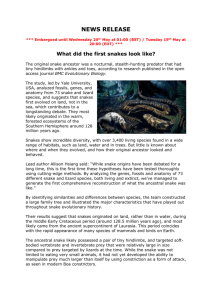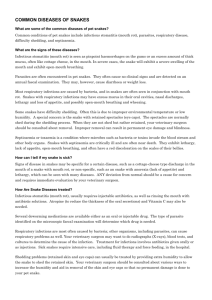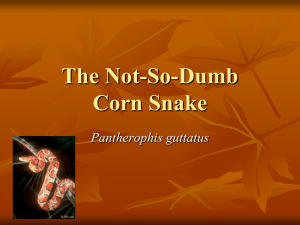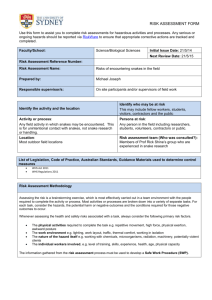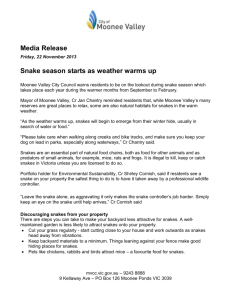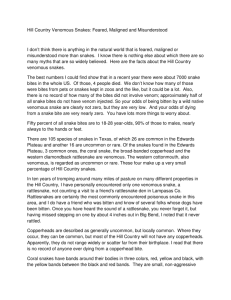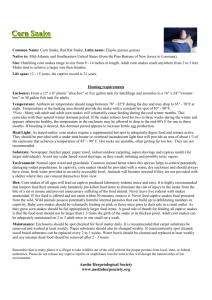HISTORY Snakes are elongate legless carnivorous reptiles of the
advertisement
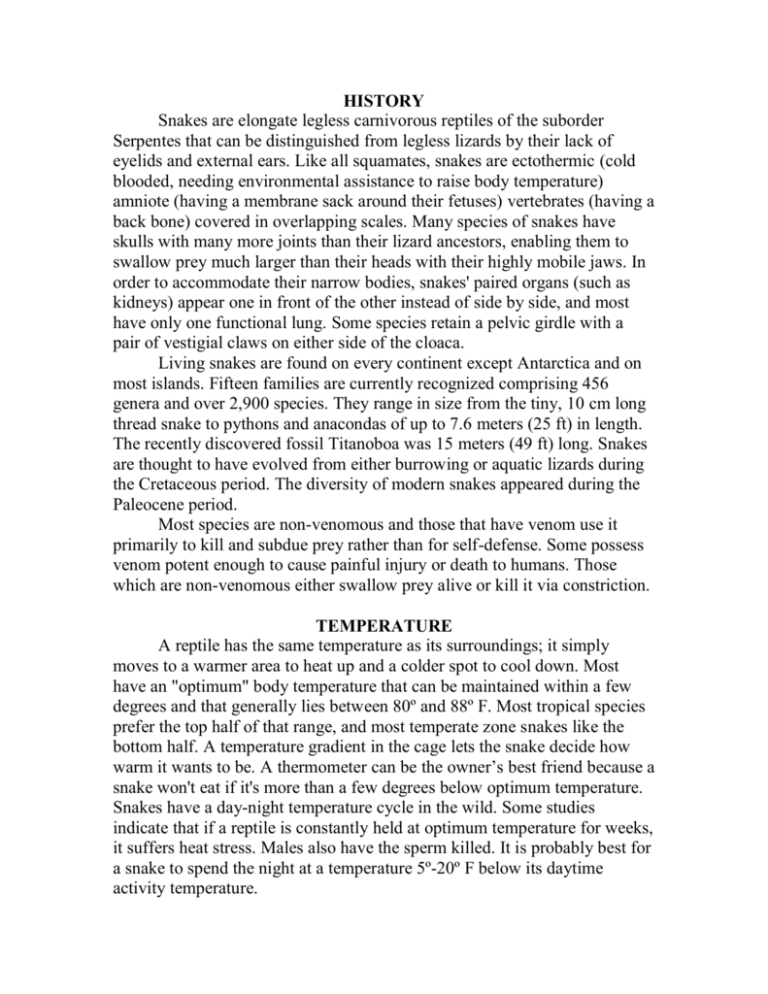
HISTORY Snakes are elongate legless carnivorous reptiles of the suborder Serpentes that can be distinguished from legless lizards by their lack of eyelids and external ears. Like all squamates, snakes are ectothermic (cold blooded, needing environmental assistance to raise body temperature) amniote (having a membrane sack around their fetuses) vertebrates (having a back bone) covered in overlapping scales. Many species of snakes have skulls with many more joints than their lizard ancestors, enabling them to swallow prey much larger than their heads with their highly mobile jaws. In order to accommodate their narrow bodies, snakes' paired organs (such as kidneys) appear one in front of the other instead of side by side, and most have only one functional lung. Some species retain a pelvic girdle with a pair of vestigial claws on either side of the cloaca. Living snakes are found on every continent except Antarctica and on most islands. Fifteen families are currently recognized comprising 456 genera and over 2,900 species. They range in size from the tiny, 10 cm long thread snake to pythons and anacondas of up to 7.6 meters (25 ft) in length. The recently discovered fossil Titanoboa was 15 meters (49 ft) long. Snakes are thought to have evolved from either burrowing or aquatic lizards during the Cretaceous period. The diversity of modern snakes appeared during the Paleocene period. Most species are non-venomous and those that have venom use it primarily to kill and subdue prey rather than for self-defense. Some possess venom potent enough to cause painful injury or death to humans. Those which are non-venomous either swallow prey alive or kill it via constriction. TEMPERATURE A reptile has the same temperature as its surroundings; it simply moves to a warmer area to heat up and a colder spot to cool down. Most have an "optimum" body temperature that can be maintained within a few degrees and that generally lies between 80º and 88º F. Most tropical species prefer the top half of that range, and most temperate zone snakes like the bottom half. A temperature gradient in the cage lets the snake decide how warm it wants to be. A thermometer can be the owner’s best friend because a snake won't eat if it's more than a few degrees below optimum temperature. Snakes have a day-night temperature cycle in the wild. Some studies indicate that if a reptile is constantly held at optimum temperature for weeks, it suffers heat stress. Males also have the sperm killed. It is probably best for a snake to spend the night at a temperature 5º-20º F below its daytime activity temperature. HOUSING Cages should be of adequate size, easy to keep clean, adequately ventilated, and escape proof. Aquariums with pegboard tops make good cages. Plastic shoe boxes and storage boxes also make good cages after enough air holes have been cut in them. Big cages can be made of wood and pegboard, but not wire mesh or screen because a snake can rub its nose raw on wire. Most snakes do not need much space. Suggested minimum cage sizes are 1/2 square foot of floor space per foot of snake for those up to six feet in length and 3/4 square foot of floor space for those six to nine feet long. Increase the suggested minimum cage sizes 25% for each additional snake. Cages must be kept clean because snakes can develop “Dirty Cage Syndrome” when droppings build up. Cages should be cleaned every week or two with a detergent and a disinfectant like 5% sodium hypochlorite bleach [Clorox for example] diluted as given on the label for woodwork. Coal tar and phenol products, like Ly-sol and Pine-sol, are toxic. Do not use them. Some kind of floor covering makes cleaning easier. Paper (including newspaper), outdoor carpet, and pea gravel are good. Shredded aspen, a fibrous wood product, is also good for medium and large snakes. Sand, soil, sawdust, and kitty litter are not good. Sand and soil don't dry well, and a wet cage encourages skin diseases. Dust from sawdust or kitty litter can give a snake incurable pneumonia. Cedar chips may be toxic. Most snakes do very well in a simple cage. All require a water bowl and some sort of hiding place. Hatchlings will coil up in the crevices in a loosely wadded piece of newspaper. A closed cardboard cereal box with a hole in a corner works for larger snakes. If the box is too big for the snake, fill it with loosely wadded newspaper. Tree snakes need a branch. Rocks, plants, and other furnishings are strictly optional. It is best to keep one snake in each cage, particularly if it's a snake eater like a kingsnake. But if snakes must be caged together, snakes of the same species are more likely to get along than snakes of different species. FEEDING All snakes are carnivorous. They never eat lettuce, carrots, bread, and similar items. The diet varies from species to species; check a reference book for each one. Individuals also show preferences. Whenever possible, the snake's natural food should be offered. Most adult snakes should be fed every week or ten days, and younger, growing snakes should eat more often. A snake can go for weeks without food if necessary, but it does better on a medium sized meal once a week rather than a huge meal every three weeks. Hungry mice have eaten captive snakes, so a live rat or mouse shouldn't stay in the cage more than an hour if uneaten. However, snakes don't require live prey. Many snakes don't care whether the food is alive or dead and some will only accept dead food. Frozen food can be used after it is thoroughly thawed. If your snake won't eat, it may be too cool, or it may want its food inside a hiding box for seclusion. It also may want something different. If a live adult mouse frightens your snake, try a freshly killed one or a live pinky. Cutting open the belly of a dead mouse produces a blood smell and a wet area that help to stimulate feeding. If nothing works, consult a veterinarian. Force feeding is traumatic and is strictly a last resort. SKIN SHEDDING Every one to three months a snake sheds its skin. The eye is cloudy for a few days, then clears, and the skin is shed a few days later. Shedding takes only a few minutes, once the old skin is rubbed loose at the lips. Most snakes refuse food during this period. Sometimes not all of the skin is shed. This seldom happens if the humidity is kept at the proper level of 40 to 70%. Daily spraying with water after the eyes clear helps to prevent problems. If some of the skin remains unshed, the snake should be soaked in a container half full of water at 70-85º F for an hour or so. Then the old skin can be gently peeled off. PARASITES AND DISEASE Snakes can suffer from many ailments - mites and ticks on the skin, worms in the gut, and protozoa, bacteria, or viruses attacking the mouth, skin, and internal organs. Even cancer has been found. New specimens should be quarantined for at least two weeks, and possibly as much as three months, so that they can be checked for parasites and disease. If the owner is not equipped to treat any diseases that occur, the snake should be taken to a veterinarian who is experienced in treating reptiles. Ticks are arthropods an eighth of an inch long or more that suck blood and carry disease. They can be gently pulled off with forceps and dropped in a vial of alcohol. Try to avoid leaving the tick's head in the snake's skin because a minor infection results. Mites are pinhead-sized, blood sucking arthropods closely related to ticks. The common snake mite almost always arrives on a snake from a pet store or other infested location. They are seldom found on freshly caught snakes. Get your snake checked out by a veterinarian to be sure of no mites. If the mites aren't detected immediately, they spread. You’re veterinarian will have proper treatment for this issue. Worm parasites are often present in the gut where most do little harm. They are detected by fecal examinations and killed with commercial wormers. SEXING AND BREEDING A snake's sex can be determined in several ways 1. Probing. This is the most reliable, but it should only be done by a veterinarian. In this method, a metal probe is slipped through the vent to check for the presence of a hemipenis, the male copulatory organ. Every male has two hemipenes in the base of the tail. 2. A simple visual examination of the tail's length and thickness. The hemipenes make the tails of males longer and thicker than the tails of females of the same size. When looked at from the side, male tails are generally half as thick at the middle as at the base. Female tails are usually half as thick a quarter of the tail's length from the base. 3. Spurs. Male boa constrictors and pythons have spurs on either side of the vent that are longer than those of the females. In general, breeding snakes requires closely copying their natural conditions. This may include a seasonal day-night light cycle with a full spectrum light like Duro-test's Vita-lite, winter cooling, and other factors. RECORDS Records of origin, feeding, shedding, and breeding should be kept. These keep track of feeding schedules and enhance a collection's value. Federal and state permits often require some form of report.

